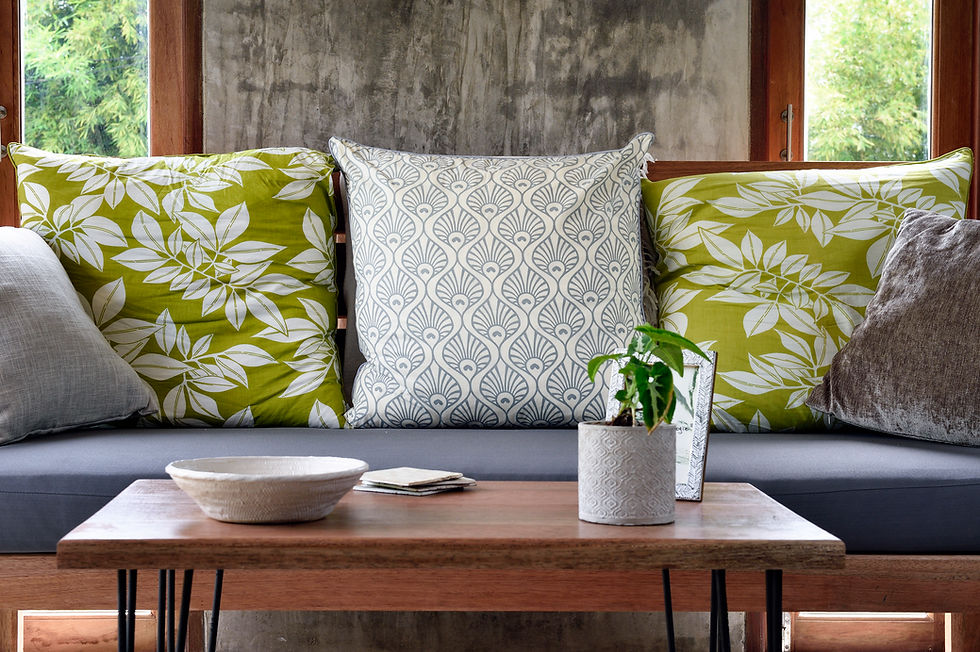Choosing Wallpaper Without Losing the Plot – Or Falling for Flamingos
- Marieke Rijksen

- Jun 30
- 3 min read
Updated: Aug 23
Let’s talk about wallpaper – because while it’s one of the most powerful tools in interior design, it also has an uncanny ability to send even the most confident decorator into a full-blown aesthetic meltdown.
You start off just wanting “a little something” for the guest loo. Three hours later, you’re questioning your entire taste level, and considering an all-over banana leaf print for the hallway – even though you live in a Dutch townhouse and not a villa in Palm Springs.
I get it. I’ve been there. And because I’ve had this conversation with students and clients more times than I can count, here’s how I personally go about choosing wallpaper without losing the plot.

Step 1: Function First. Always.
Before I even look at pattern, colour or texture, I check the practicality of the wallpaper. Where is it going? What kind of wear and tear will it face?
High-traffic hallway or bathroom? Go for vinyl or washable paper – easy to clean, moisture-resistant, and less prone to damage.
Bedroom or home office? You can get away with something a little more delicate.
Rental space or short-term experiment? Peel-and-stick options have come a long way and can be incredibly effective.
Form is fun. But if the function’s wrong, it’ll never work long-term.

Step 2: Style Over Hype
This is where a lot of people get stuck. You see a gorgeous print, it's trending on Instagram, it’s featured in five interiors magazines – and you’re sold. But… is it right for your space?
Wallpaper has to work with the mood and overall design direction of the room. Not every stunning pattern belongs in your home, and that’s not a failure of taste. It’s just context.
Ask:
Does it align with your vision for the space?
Is it enhancing the atmosphere or fighting against it?
Will it age well in this room?
Trust your gut. If it feels off now, it won’t magically feel better after it’s on all four walls.

Step 3: Colour as the Cohesive Thread
Colour is often what ties a room together – or what makes a wallpaper feel like a misplaced scarf. So I always look at how the wallpaper’s colours interact with the broader scheme.
Ask:
Is one of the colours already present in the room?
Is it complementary to the dominant tones in the space?
Can I pull that same colour into other elements – cushions, curtains, artwork – to create continuity?
This isn’t about matching. It’s about echoing and layering – letting the eye travel smoothly across the space rather than being stopped in its tracks by a rogue wall.

Step 4: Texture, Baby
One of the most underrated elements in wallpaper selection is texture. And I’m not just talking about raised patterns or grasscloth weaves (although I love those too).
Texture can:
Soften a space that feels too cold or clinical
Add depth to an otherwise flat colour palette
Help with acoustics in echo-prone rooms
Shift the light in interesting, atmospheric ways
A room that’s already busy in form and finish probably doesn’t need more visual noise. But in a minimal space? Texture is your best friend.

Step 5: Sample It – Then Stop Thinking
I always order samples. Always. And then I tape them up and live with them for a few days. Morning light, evening light, overhead light – I want to see what the paper actually looks like in the space, not just on a screen.
And then, the most important bit: I make a decision. I give myself a deadline and I move forward.
Because here’s the thing: the “perfect” wallpaper doesn’t exist. But the right one for your space, mood, and lifestyle probably does. It just won’t introduce itself unless you give it a fair chance.

Final Thought
Wallpaper should be joyful, not paralysing. The goal is never perfection – it’s a room that feels coherent, considered, and unapologetically yours. If it makes you smile every time you walk past it, you’ve chosen well.





